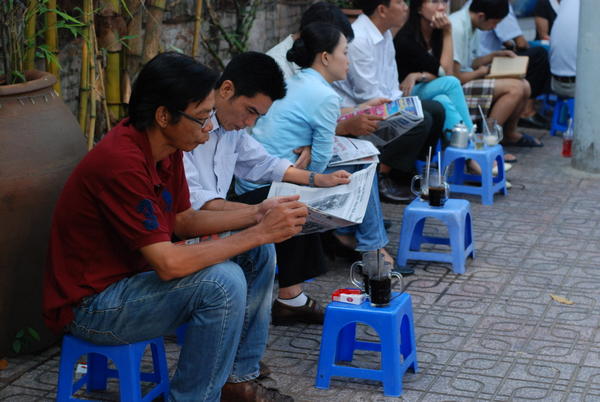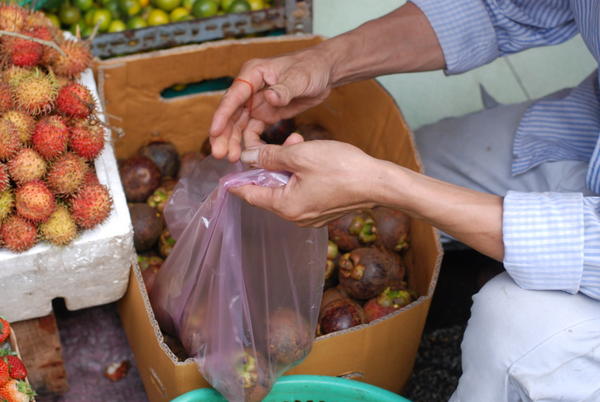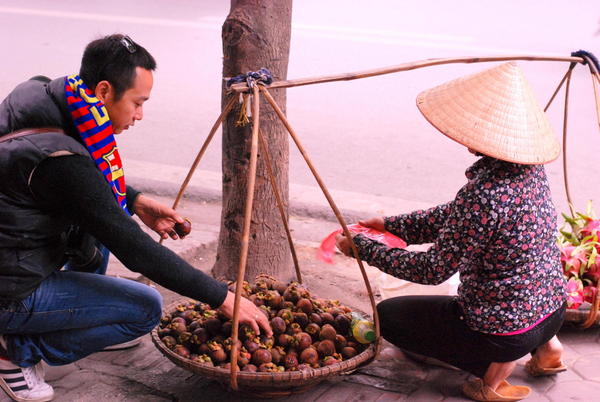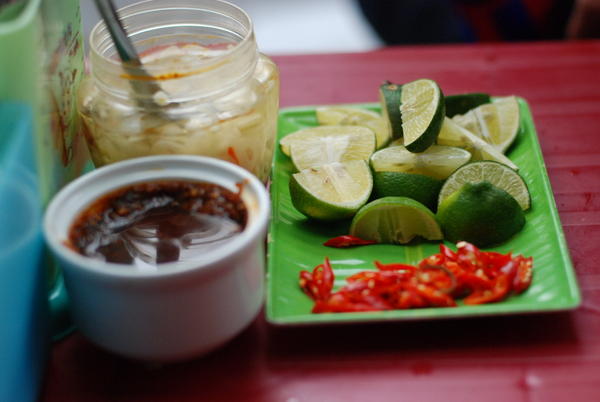Over brunch last week, my friend Mike - who's been to a lot of places, but never Southeast Asia - asked me what made me want to visit Vietnam. Actually, I think he asked me if the motivation was purely the country's food. Can I answer honestly without sounding totally uncurious about everything else? Yes. I wanted to go to Vietnam for the food. Just the food. (Fortunately, D takes an interest in pretty much everything else. Or should I say, anything else. Opposites attract, yes?)
The thing about Vietnam - and Thailand, for that matter - is that in many ways, the food is the country. Maybe it's true of any place; all my friends always talk of visiting Italy, and I guarantee you they didn't choose it just for the museums. Eating your weight in pizza is a great way to spend a holiday. For me, eating my weight in pho has similar appeal.
But it's more than the taste of the broth, the texture of the noodles, the 17 kinds of mint each different from the next. Food ways tell you so much about a place and a group of people that you can't learn by visiting a museum. Getting out on the street (and in Vietnam, food literally is on the street) and eating with others is the fastest way to understand the rhythms and pulses of a place. I ate with a lot of strangers on this trip, and when the lady across the table from me barked orders about how to position my bean sprouts just so, about how I was putting the wrong sauce on my noodles, I learned something. Next time, I'll use the green sauce. Also: the Vietnamese take their food very, very seriously.
I took nearly 1,000 pictures of ladies pointing to green sauce, among many other things. Here are some highlights.
The morning starts like this. If you aren't on a motorcycle heading to work, you're squatting at one of these little "cafes," which really are just little areas of the sidewalk that have plastic stools and coffee carts. You're drinking coffee, and it's very strong. If you ask for milk, you get sweetened condensed. You can have your coffee hot or cold, but folks are very opinionated about when you should have milk (cold) and when you really should just drink it black (hot).
An hour or so into the morning, vendors start setting up. You can get anything from fresh fruit to soup to snacks and beyond from carts on the street. Most of the vendors don't speak English; luckily, they each sell only a few different things. Point to what you want, hold up however many fingers, and you'll be paying and on your way in a flash.
Not all vendors stay put. When they move, they do so very precariously. Had the folks carrying huge sacks, electric equipment, PVC piping, and even 2 children, seemed even a little bit concerned for their safety, I might have been, too. But everyone keeps calm and carries on. For better or for worse (mostly for worse?) motorcycles are treated like pickup trucks.
Ho Chi Minh feels at times like no one is sitting still and everyone is on the road. Crossing the street is an exercise in patience and finger-crossing. But there are quiet spaces in the city, and one of them is the zoo. We saw zebras, giraffes, funky birds, and even a beautiful peacock who spread its feathers for us. In a city as hot and bustling as HCMC, it's nice to see some green.
We spent a couple days in Hanoi, Vietnam's capital and largest northern city. There's definitely a culture of leisure in Hanoi, and I loved watching middle aged men unwind over beers and board games. It reminded me of the men in Tel Aviv and in East Jerusalem who sit over tea and play "shesh besh" (backgammon).
Our second day in Hanoi, we enlisted the help of a professional: Tu Van Cong works for Hanoi Street Food Tours and blogs at Vietnamese God. For over a decade, he's been guiding tours of food and other stuff in Hanoi, HCMC, and elsewhere (especially Nha Trang and other areas of the south, where he's from). When he's not guiding, he's scouring the streets for the next tiny, imperceptibly small food stall with the most amazing thing you've never tried. He's got loads of secrets up his sleeve, and we were privileged to learn some of them during a full-day tour.
One of our earliest stops was a tiny hole in the wall where a family of three lives and maintains their restaurant. The kitchen (i.e. 2 burners and a metal cart for ingredients) is out front, and there's a cot in back, in the same room as the three plastic tables where customers eat. This, we learned, is actually quite common. Despite the fact that Vietnam is a relatively poor country with a low cost of living, real estate in the major commercial areas is very, very expensive - making it cost prohibitive to have separate spaces for a restaurant and a home.
Tu chose this place because the cook works with local farmers and uses only sustainable animals in her cooking. A place in the States that used ingredients like these would have been fancier and way more expensive. Our bowls of broth and noodles (with optional chicken or other bits) cost about 30 cents each:
Later in the day, we walked through a few markets. Not unlike the shuk in Israel or the bazaars of Turkey, Vietnamese markets consist of stalls each serving just one item or set of items. Here, for example, was a stall selling only soy products:
Her tofu was really gorgeous.
Needless to say, there were many stalls devoted to seafood, both fresh and preserved. I don't use shellfish in my cooking, so I don't know much about these different types, but I was bowled over by the shapes, sizes, and colors of the different varieties. My guess is that different dishes require different varieties. I've always thought shrimp was shrimp - but clearly, that's not the case!
Oddly, the same is true for mint. Tu picked up a leafy bundle and made us smell it. It smelled fresh and pungent. I asked what it was; he said mint. Then he picked up another. Sweet and floral, this one. What was it? Mint. A third: grassy and clean. Mint. You get the idea.
Another revelation in the category of "things you think you've tried but haven't:" bananas. They are so, so different in both Vietnam and Thailand than in the US. There are so many varieties, and the small ones are so much sweeter and more delicious than anything I've had before. And you don't just eat the fruit - you also eat the flowers and the stems. That picture above is a banana trunk; below, you can see what it looks like when shredded, which the vendors at the market do for you. And below that, there's a picture of a banana flower, which figures prominently in the cuisine as well.
While we're talking about produce, we need to discuss fruit. Before we left for the trip, everyone who'd been to either Vietnam or Thailand told us to eat a lot of fresh fruit for them. Sure enough, fruit is everywhere. It's cheap. It's exotic. And it's absolutely delicious. The mangoes are bright orange and soft and fragrant. The melon is sweet and juicy. Even dragonfruit, which has only ever been mealy and bland, was crunchy and flavorful. And the mangosteens! I went nuts for mangosteens. They really have no flavor analogue: less tangy than passionfruit but more than mango, uniquely fragrant, and with an addictive texture. I went through a bag of mangosteens every day.
Tamarind figures heavily into Thai cooking, but it's also used occasionally in Vietnamese food. On the streets of Hanoi, as in Bangkok, Tamarind was on sale in the street. Had I a second suitcase and no customs line to get through, I'd have bought some.
One of our earliest stops was to what Tu called "the party street," a street in Hanoi lined with shops that sell glutenous rice confections traditionally handed out at weddings and other celebrations. There are a few different varieties, but my favorite by far was these green rice cakes, made of rice, pandan leaf (which gives both color and fragrance) and mung bean paste inside. They're sweet, chewy, and kind of addictive. I was mesmerized by the crowd making these cakes, so much so that I went back to that street on my own to watch a bit longer (and stock up).
Rice figures heavily into snacks here. There are cakes and cookies, crackers in every shape and size, and even snacks made of rice stuffed with either meat or fish, wrapped in betel leaves and tied up with a bow. I love rice crackers, but I like how they look even more than how they taste:
There are just so many varieties.
At some point, D and I started to worry that it was nearing 10 and we were without coffee. Like clockwork, Tu hit us with a 1-2 punch: two coffee shops in a row. Both were memorable - the second had homemade passionfruit frozen yogurt on offer, too - but I'm still thinking about the first one. It's right on the edge of the old city in Hanoi, and it makes one of the best coffee drinks I've ever tasted:
It's called egg-coffee (imagine my excitement when I was told this was what we'd be drinking!) but it's more like drinkable custard with coffee underneath. Tu said they make it by taking tempered egg yolks and whipping them in a blender with something. He didn't know what the something was - cream? coffee? - and he said there was no way I could make this at home. So there you have it. But it really was just lovely. The right balance of sweet and creamy, but still with plenty of strong coffee punch. Perhaps the nicest touch? They serve the coffee in a hot water bath, to help keep it warm.
If we hadn't had a guide to show us his favorite stalls, we'd probably have just followed our noses. On every corner, there was a vendor - usually several - cooking something hot and delicious. This woman was deep-frying tofu, which she served with spicy, pungent sauce for dipping. But pretty much anywhere you turned, someone was sitting over a hot stove, cooking something worth eating.
But if you know where to go, you can seriously hit the jackpot.
Tu took us to a stall on quiet street that I'd have passed 1,000 times without noticing. It had a foggy glass case out front with lots of fried fish lining the shelves, and a covered cauldron engulfed in steam. No chairs, no tables. When we arrived, they pulled a table and three stools from the back and set them up on the sidewalk for us. Tu started ordering in Vietnamese. The only words I could make out were "bun ca." Not to be confused with bun cha, the legendary Hanoi dish of noodles and grilled pork, bun ca is fish noodle soup traditionally made with mackerel. The version we tried - it's hard to imagine there's a better version - had both baked and fried mackerel, a deep, savory, spicy broth with tomatoes and plenty of chile, and handmade rye noodles:
Those noodles easily rival the best pasta I had in Italy. They held their own, both flavor- and texturewise, in an intensely flavored broth.
When the soup came, we personalized our bowls with chile, pickled garlic, fresh herbs, and fresh limes:
Tu kept telling us to pace ourselves - there was still so much to eat - but we couldn't resist: we finished our bowls of bun ca.
After the bun ca, we walked off some of our morning intake. I couldn't believe how foggy the city was. With the exception of our first day in HCMC, we spent our time in Vietnam in weather like this:
And the strange thing is, the grey sky doesn't mean it's cloudy or going to rain. It's pollution. Straight-up smog. I didn't believe it at first, but December isn't a rainy season. The smog is pervasive.
Fortunately, our umpteenth stop on the food tour provided some respite. This was another one of my favorites. Same story as before: unassuming hole-in-the-wall on a crowded street. One-woman operation: a few stools at her counter, big bowls of ingredients, and a few motorcycles parked out front. From the looks of it, you'd never know this lady makes the best bánh cuốn in the city:
First, definitions: bánh cuốn are northern Vietnamese rice crepes. They can be served plain or with any number of fillings (egg, mushroom, pork). When made well, they are impossibly delicate, with fresh, vibrant filling and punchy dipping sauce.
To the right of our crepe maker was a huge crepe pan with a patina years in the making. It's set over a pot of boiling water and covered by an equally huge domed lid used to set the crepes.
At her feet, a pile of the most beautiful mushrooms I've ever seen up close:
In the morning, she chops up these mushrooms and cooks them into an umami-bomb of a filling:
When it comes time to make the crepes, she spreads a thin layer of batter onto her pan and immediately covers it with the lid. If she's filling the crepe with egg, she adds it immediately after spreading the crepe:
There's a clear rhythm here: she's tapping her feet, looking around, touching the lid. But she's not lifting that lid, not for a moment. Finally, after an impossibly long three minutes, she lifts the lid, and uses a round wooden tool to peel that thin, delicate rice crepe off the pan:
Then comes the filling and rolling:
As you can see, she doesn't sweat the tears in the crepe. She just rolls the thing up, snips it (with scissors!) into bite-sized pieces, plops them on a plate, and hands you a plastic bowl filled with nuoc mam and kumquat juice. It is a snack for kings. I'm still dreaming about it.
In case there was even a slight chance we were still hungry, the next three hours were filled with more food. We ate our way through a bag of mangosteens (duh), four bowls of noodles (no, really: four different bowls, each perfectly composed and balanced), fish cakes, fried rice flour donuts, and seriously, more. I can't even believe we ate all that food. I posted a bunch of noodle photos on instagram and facebook, if after this post you still haven't had your fill. (I wouldn't blame you.)
One favorite from the afternoon was a spot set in an abandoned garage along the water in the northwest of the city. The real estate in that area is exceedingly expensive, but the eateries look the same as elsewhere in the city: no frills, plastic tables and stools, a few big burners, and that's it. In this garage, we found two guys slaving over a hot stove deep-frying impossibly fresh tofu:
You can order the tofu soft or hard (lightly fried or fully-crisped). Naturally, we ordered both - the gluttons we are. The tofu is typically served with an incredibly pungent fermented shrimp paste, but this place also makes a really lovely sauce of tomatoes, chiles, onions, fish sauce, and more. It's the kind of thing I could make at home, if I had the recipe...alas, language barriers prevented me from getting much more than an ingredient list.
The language barriers prevented me from really speaking much to anyone. Most of our communication happened via vigorous motioning and made-up sign language, head-shaking and head-bobbing as appropriate, and lots of gracious/pleading smiles. Maybe that's why one of the moments that most stands out for me is from our last morning in Hanoi, when I left D with her coffee and croissant at the hotel and ventured around the corner for one last Vietnamese breakfast. There was a woman on the opposite corner with one burner, a bunch of little bowls, and a small swarm of people eating on the street next to her. I assumed whatever she was making was good. Turns out, she had more of those bánh cuốn that I so love. But she also had these crisped rice cakes filled with mung bean and mushrooms and topped with spicy red chile sauce. We quickly realized that neither of us spoke each other's language, but 10 minutes later, I had breakfast. I'd held up the number of fingers worth of rice cakes I wanted, pointed to delicious-looking condiments, gestured toward the street to tell her I wanted it to-go, and smiled vigorously as she understood each of my requests. Our communication was entirely silent, but we understood each other. The man eating right next to where I was squatting looked delighted a) that I so wanted whatever he was eating, and b) that I'd managed to get it without saying a word. I always say that food helps people connect, and my last morning in Hanoi was that simple fact on display.
Well, this was epic...wasn't it? Next up: Thailand. But first, a recipe. I've been cooking a lot of January-friendly food and I can't wait to share it with you. Stay tuned.






































